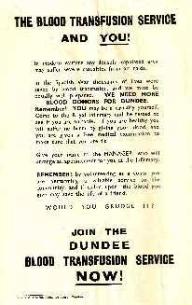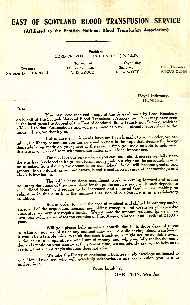Blood Transfusion

Prof Dan Cappell
Before the war, blood transfusion was a rare event in British hospitals, but with the prospect of war looming, it was decided to set up blood banks in the major hospital centres. This duty in Dundee fell to the Professor of Pathology Dan Cappell, assisted by Haematology lecturer Dr Henry Hutcheson, and a young student who later went on to serve the people of Tayside for 30 years as Professor K G Lowe. They would go to various centres, often cottage hospitals, in Tayside and Fife to collect pint-sized bottles of blood from volunteer donors. On one occasion Cappell crashed his car into a wartime road barrier during the blackout, breaking Hutcheson's wrist, but fortunately not the precious bottles!
Blood tranfusion documents - click on the images to see them full size
(Courtesy of Blood Tranfusion department, Ninewells Hospital)
Doctors in Service
Many local medical staff found themselves in active service far from home. All three Services had their own medical branches, but the majority went into the Royal Army Medical Corps (RAMC). Most were Regimental Medical Officers (RMOs) attached to a unit such as an infantry battalion or an artillery regiment. They followed their regiment wherever it went, and treated casualties in the front line. The RMO had also an RAMC sergeant and if he was lucky, four RAMC corporals, one for each rifle company. The medicals also had help from bandsmen in the regiment - in Highland regiments this meant pipers and drummers. The RMO always had help from the unit Padre, with whom he worked in the Regimental Aid Post near to the headquarters of the battalion. Many padres were decorated for their bravery in action as well as the medical officers.
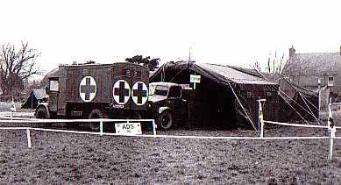

Left:An Advanced Dressing Station in Normandy
Right:A new casualty arrives at reception, 1944
(Courtesy of Mr John Blair)
After being carried to the Regimental Aid Post, casualties were transferred by ambulance back to the next RAMC unit, the Field Ambulance. Dundee's unit was 153 Field Ambulance. Its successor is the only RAMC unit which may officially wear a Tam O'Shanter today. Further back came the Casualty Clearing Stations and Field Hospitals, and here female nursing sisters appeared for the first time.
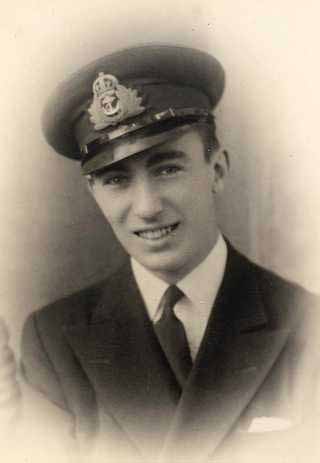
Dr John Macrae (Courtesy of Dr Bill Macrae)
Dr John Macrae graduated in 1936, started surgical training, and volunteered for the Royal Navy in 1940. He served for most of the war on the destroyer HMS Cattistock, often escorting convoys on the North Atlantic run. He saw action at Dunkirk and was part of one of the first medical teams at Normandy on D-Day. As ship's doctor, he was expected to treat casualties from both his own ship and also those from the ships in the convoys they were escorting. Part of his duties involved evacuating injured men from these ships, and he had harrowing stories to tell of trying to extricate badly injured seamen from the engine rooms of burning tankers.
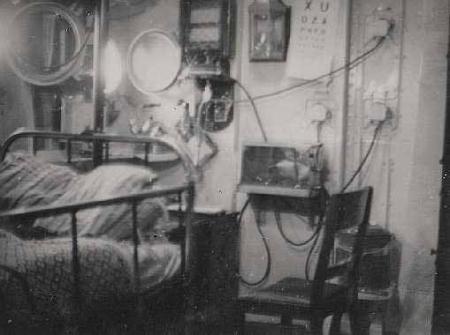
Photo from Dr Macrae's photo album, showing the sick bay on board the HMS Cattistock (Courtesy of Dr Bill Macrae)
Captain Bill Wilson, later a consultant physician at Perth Royal Infirmary, was sent on a special assignment from India to study casualty evacuation in North Africa. A copy of his report is included in the exhibition. He later served as Senior Medical Officer at HQ in Delhi at the time of India's independence in 1947.

Captain Isma Begbie (Courtesy of Mr John Blair)
Captain Isma Begbie from Broughty Ferry was a Medical Officer in 105 General Hospital, based in Normandy then Belgium. Note the unexploded mine behind her head in the photo above!
Kathleen Hunter qualified as a nurse at Perth Royal Infirmary in 1942, then joined the Queen Alexandra Imperial Military Nursing Service and served in Palestine for two years. After the war she worked at Blairgowrie Cottage Hospital (as Sister Kench). The cape she is wearing in the photograph below is displayed in the exhibition.

Kathleen Hunter (Courtesy of Mr Joe Richards)
The war also brought foreign medical staff and students to Scotland. Read about the story of a Polish medical student in Dundee.
Previous Page
